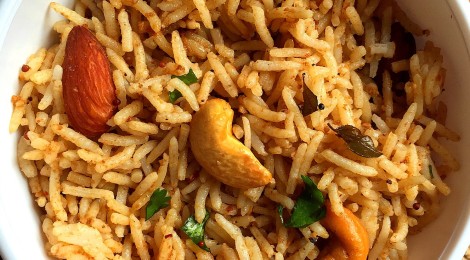
South India’s Signature Rice Dish: Tamarind Rice (Puliyogare)
I’m not sure where to begin to explain my addiction to Tamarind Rice. Puliyogare as it’s called by South Indians, is translated as “sour rice” that might sound like a one-note dish and potentially boring, but it’s so much more than that. It’s a complex blend of classic South Indian flavors like sour tamarind, sweet jaggery (brown palm sugar), peppery mustard seeds, ground spices like coriander and red chilli, and smoky kari patha (curry leaves). You start by making a thick, shiny tamarind paste that involves soaking whole tamarind in cold water and then tempering it with whole spices, ground spices, sugar, and curry leaves in hot oil. After the paste is combined with salted peanuts or cashews, it’s gently folded with freshly steamed white rice so that each slender grain is coated with tamarind goodness.
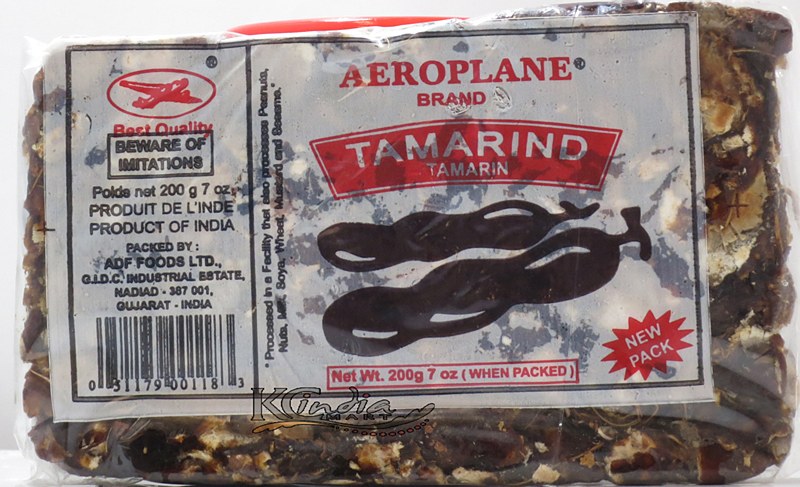
You can find packaged dry tamarind in any Indian, Thai, or Chinese grocer. And of course, online, even on Amazon 🙂 It will run you about $2 for the whole package, you will only need a small amount for this recipe, and the rest will last a long time in your cupboard. (Photo Source: indiangrocery.com)
There are countless online recipes for Tamarind Rice (just Google it, you’ll see) and nearly every South Indian family has their own version that tastes slightly different, even if all the main ingredients are the same. My aunt Prabhamani who lives in Davangere in the southern Indian state of Karnataka makes the best puliyogare I’ve ever had. Because tamarind is so sour, the trick to making an exceptional Puliyogare is to get the balance right. Mani Aunty has a way of balancing each ingredient to coax out each flavor in just the right way so one doesn’t overpower the other — just the right amount of sour, sweet, salty, spicy, and pungent flavors in one spoonful. The result is sublime. Sean says it’s like crack, and we don’t make it often, because honestly, we could easily inhale an entire tub of puliyogare in one sitting. But when we do crave it, it’s Mani Aunty’s version that I make and her recipe that I share with you here.
South India’s Signature Rice Dish: Tamarind Rice (Puliyogare)
Serves 6-8
Ingredients
For the tamarind paste
- 2/3 cup tamarind (use dry tamarind as pictured above, not tamarind concentrate)
- 2.5 cups cold water
- 3 tablespoons canola oil
- 1/2 teaspoon mustard seeds
- 1 teaspoon salt
- 3 tablespoons brown sugar
- 1.5 teaspoons rasam powder*
- 1.5 teaspoons channa dal, dry roasted and powdered
- 1.5 teaspoons urad dal, dry roasted and powdered
- 2 teaspoons dry coconut
- 2 teaspoons sesame seeds, slightly dry roasted on low heat and powdered
For the tamarind rice
- 1 cup white basmati rice, uncooked
- 2 teaspoons canola oil
- 6-8 kari patha (curry leaves)
- 2 tablespoons peanuts or cashews (or a combination of both)
- 2-3 teaspoons tamarind paste
*Rasam powder (also known as saaru powder) can be made by combining 1/2 teaspoon each of chilli powder, coriander powder and cumin powder.
Preparation
For the tamarind paste
- Soak tamarind in water for a minimum of two hours, until it is soft and loosened.
- Squeeze the tamarind with your fingers to release more pulp into the water. When ready, the water will look like a thick brown liquid. Discard the small pieces of tamarind remaining.
- Pour the tamarind liquid through a sieve with large holes to remove any bits of skin, seeds, etc. You should be left with a smooth, thick tamarind liquid.
- In a medium saucepan, heat oil with mustard seeds on medium heat, closing the saucepan with a tightly fitting lid. You will hear the mustard seeds begin to pop — it will sound like popcorn. As soon as it goes quiet, remove from heat, lift the lid and add the tamarind liquid. (Hold the saucepan away from you when you’re adding the tamarind liquid because it will splutter).
- Add salt and brown sugar, and mix well.
- Bring it to boil, and reduce heat and simmer for 10-15 minutes, until the tamarind liquid reduces to a jam-like consistency.
- Add rasam powder, channa dal powder, urad dal powder, dry coconut and sesame seeds. Mix well.
- At this point, it is important to taste and adjust the seasoning, particularly for salt, brown sugar and rasam powder. This is very important step, as every rasam powder is different. For example, if it is too sour, you can add more brown sugar to taste.
- The tamarind paste is now ready, and can be kept in the refrigerator for six months (tamarind is a natural preservative).
For the tamarind rice
- Cook 1 cup of basmati rice. When it is done, gently fluff the rice with a fork and let it cool for a few minutes.
- In a small saucepan, heat 2 teaspoons of oil on medium heat until warm. Add kari patha (curry leaves), nuts (peanuts or cashews) and 2-3 teaspoons of the tamarind paste. Stir well.
- Depending on how thick the paste is, add water a small amount at a time, until it reaches a sauce-like consistency. Turn off the heat.
- Add the tamarind paste to the cooked basmati rice, mix gently until the rice is evenly coated. Enjoy!
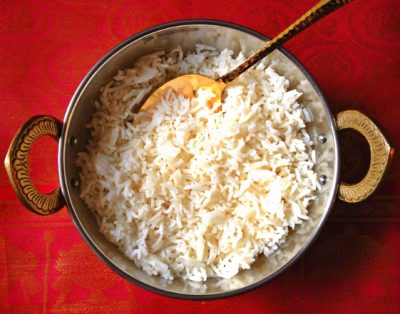


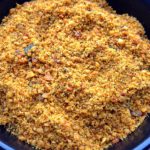
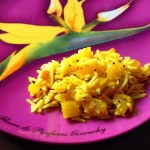
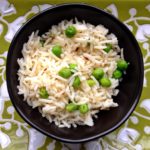
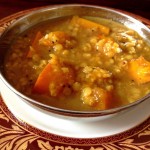
Im addicted to puliogare as well. I eat it about 3 times a week. I dont have time anymore to make it by hamd so i buy the MTR puliogare paste. Its extremely tasty.
Hello Tami! Puliogare is indeed so addictive. As I said in the post, my husband Sean loves it and we would eat it everyday if we could. You’re right, MTR makes many useful pastes. I sometimes add a few things to the MTR paste (like jaggery and peanuts) to balance out the flavors.